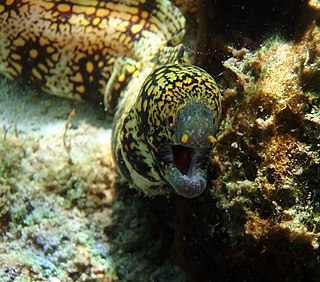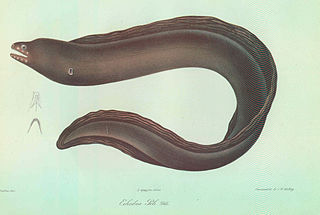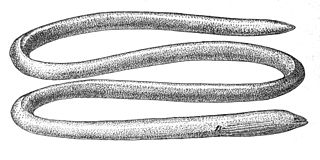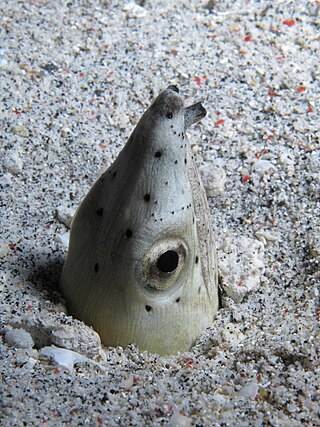
Echidna is a genus of moray eels in the family Muraenidae.

The barred moray, also known as the banded moray, the dark-banded eel, the girdled moray, the girdled reef eel, the many banded moray eel, the ringed moray, the ringed reef moray, the striped moray and the zebra eel,) is a moray eel of the family Muraenidae. It was described by John Richardson in 1845, originally under the genus Muraena. It is a marine, tropical eel which is known from the Indo-Pacific, including the Red Sea, East Africa, the Hawaiian Islands, the Marquesan Islands, the Tuamotus Islands, the Ryukyu Islands, and the Great Barrier Reef. It dwells at a depth range of 2 to 20 metres, and leads a benthic lifestyle in reefs and shallow lagoons. Males can reach a maximum total length of 72.3 centimetres (28.5 in). It is sometimes confused with the Zebra moray (Gymnomuraena).

Echidna amblyodon, the Sulawesi moray is a moray eel found in the western central Pacific Ocean. It was described by Bleeker in 1856, originally under the genus Muraena. It is a marine, tropical eel which is known from Indonesia, in the western central Pacific Ocean. Males can reach a maximum total length of 20.5 centimetres (8.1 in).
Echidna leucotaenia, the whiteface moray, also known as the white-banded moray eel, is a moray eel. It was described by Schultz in 1943. It is a tropical, marine and freshwater eel which is known from the Indo-Pacific, including East Africa, the Line Islands, the Tuamotu Islands, and Johnston Island. It dwells at a depth range of 0 to 24 metres, and leads a benthic lifestyle in reefs. Males can reach a maximum total length of 75 centimetres (30 in).

Echidna nocturna is a moray eel found in the eastern Pacific Ocean, in the Gulf of California and around Peru and the Galapagos Islands. It was first named by Cope in 1872, and is commonly known as the freckled moray or the palenose moray. It was discovered that Echidna nocturna and Muraena acutis are the same species.

Echidna peli is a moray eel found in the eastern Atlantic Ocean. It was first named by Johann Jakob Kaup in 1856, and is commonly known as the pebbletooth moray.
Echidna rhodochilus is a moray eel found in the Pacific and Indian oceans, around India and the Philippines. It was first named by Bleeker in 1863, and is commonly known as the pink-lipped moray eel.
Echidna unicolor is a moray eel found in coral reefs in the Pacific and Indian Oceans. It was first named by Schultz in 1953, and is commonly known as the unicolor moray or the pale moray. It is usually completely tan or light brown in color, aside from a dark ring around each eye.

Muraena augusti is a moray eel found on the eastern Atlantic ocean on waters surrounding the archipelagos of the Azores, Madeira, the Canary Islands and Cape Verde. It was described by Johann Jakob Kaup in 1856, originally under the genus Thyrsoidea. It is non-migratory, and dwells at a depth range of 0 to 250 metres, most often at around 0 to 50 metres.
The Celebes longfin eel is an eel in the family Anguillidae. It was described by Johann Jakob Kaup in 1856. It is a tropical eel known from freshwaters in the Western Pacific, including Indonesia, the Philippines, New Guinea, and Western and American Samoa. The eels spend most of their lives in freshwater but migrate to the ocean to breed. Males can reach a maximum total length of 150 centimetres.
The Polynesian longfinned eel, also known as the Pacific long-finned eel, is an eel in the family Anguillidae. It was described by Johann Jakob Kaup in 1856. It is a tropical eel found in freshwaters in the Pacific, including Sulawesi, Indonesia; the Society Islands, and Pitcairn. The eels spend most of their lives in freshwater, but migrate to the ocean to breed. Males can reach a maximum total length of 100 centimetres, while females can reach a maximum TL of 165 centimetres and a maximum weight of 9,000 grams.

Moringua bicolor, the bicolor spaghetti eel, is an eel in the family Moringuidae. It was described by Johann Jakob Kaup in 1856. It is a marine eel known from Japan, Indonesia, the Philippines, and the Laccadive Sea, in the Indo-West Pacific. It dwells in temperate waters at a known depth of 3 m (9.8 ft).

The Java spaghetti eel, also known as the Java thrush-eel, Java worm eel, and the black-tailed thrush eel is an eel in the family Moringuidae. It was described by Johann Jakob Kaup in 1856, originally under the genus Aphthalmichthys. It is a tropical, marine eel which is known from the Indo-Pacific, including East Africa, the Tuamoto Islands, the Ryukyu Islands, and Micronesia. It is a burrowing species which inhabits reefs at a depth range of 2–15 m. Males can reach a maximum total length of 120 cm.
Gnathophis capensis, the Southern Atlantic conger or southern conger, is an eel in the family Congridae. It was described by Johann Jakob Kaup in 1856, originally under the genus Leptocephalus. It is a subtropical, marine eel which is known from the southeastern Atlantic Ocean, including from False Bay to Plettenberg Bay, South Africa and also on Tristan da Cunha Island. It is known to dwell at a depth of 100 metres. Males can reach a maximum total length of 37 cm.

Cirrhimuraena chinensis is an eel in the family Ophichthidae. It was described by Johann Jakob Kaup in 1856. It is a tropical, marine eel which is known from China and Papua New Guinea, in the western Pacific Ocean. Males can reach a maximum standard length of 54.8 centimetres.

The highfin snake eel (Ophichthus altipennis, also known as the blackfin snake eel or the black-finned snake eel, is an eel in the family Ophichthidae. It was described by Johann Jakob Kaup in 1856, originally under the genus Microdonophis. It is a marine, tropical eel known from the eastern Indian Ocean and northwestern and western central Pacific Ocean, including Australia, French Polynesia, Indonesia, Japan, the Marshall Islands, Malaysia, the Philippines, and Papua New Guinea. It dwells at a depth range of 0 to 40 m, and forms burrows in soft inshore sand sediments. Males can reach a maximum total length of 103 cm.

The Napoleon snake eel is an eel in the family Ophichthidae. It was described by Johann Jakob Kaup in 1856, originally under the genus Poecilocephalus. It is a marine, tropical eel which is known from the Indo-Pacific, including Durban, South Africa, Mauritius, Indonesia, Japan, Australia, and the Penghu Islands. It is known to dwell at a depth of 20 metres (66 ft), and inhabits lagoons and reefs; it forms solitary burrows in sand sediments. Males can reach a maximum total length of 75 centimetres (30 in).
Ophichthus brasiliensis is an eel in the family Ophichthidae. It was described by Johann Jakob Kaup in 1856, originally under the genus Centrurophis. It is a marine, tropical eel which is known from Brazil, in the southwestern Atlantic Ocean.

The Pacific snake eel is an eel in the family Ophichthidae. It was described by Johann Jakob Kaup in 1856, originally under the genus Muraenopsis. It is a marine, subtropical eel which is known from the eastern central and southeastern Pacific Ocean, including California, USA, Peru, the Gulf of California, Mexico, the Galapagos Islands, Colombia, Ecuador, Costa Rica, El Salvador, Honduras, Guatemala, Nicaragua, and Panama. It dwells at a maximum depth of 155 metres (509 ft), and forms burrows in mud and sand sediments. Males can reach a maximum total length of 115 centimetres (45 in), but more commonly reach a TL of 80 centimetres (31 in).

The Kaup's arrowtooth eel is an eel in the family Synaphobranchidae. It was described by James Yate Johnson in 1862. It is a marine, deep water-dwelling eel which is known from the Indo-Western Pacific and eastern and western Atlantic Ocean, including the Faroe Islands, Iceland, Cape Verde, the Western Sahara, Nigeria, Namibia, South Africa, Greenland, France, Saint Pierre and Miquelon, the United Kingdom, Ireland, the Philippines, Portugal, Spain, the Bahamas, Brazil, Canada, Cuba, Japan, Australia, Mauritania, Morocco, and Hawaii. It dwells at a depth range of 120 to 4,800 metres, most often between 400 and 2,200 metres, and inhabits the upper abyssal zone on the continental slope. It is intolerant of the temperatures of higher waters. Males can reach a maximum total length of 100 centimetres (39 in).












